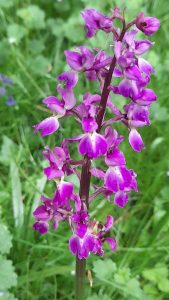Please see the below update from our Chairman, Pete Coe:
Monthly Archives: May 2025
Sussex Wildlife Trust
SWARD WARDENS: the incredible role of dung beetles June 2025
By Kerry Williams: Communications Officer – Conservation
There’s a subject we’re not great at talking about in the UK; poo. However, there’s a group of creatures that are far more celebratory of the topic, with their diet testament to their appreciation. Aptly named, dung beetles eat poo. And they are amazing.
You are likely to conjure the image of Heliocopris, giant dung beetle species which reside in Africa and Asia, manoeuvring huge droppings kindly deposited by some of the Earths spectacular megafauna. Although these beetles don’t match the size of the one that rolled a football into the 2010 World Cup opening ceremony, they are hefty for a beetle, reaching lengths of up to 7cm.
Our dung beetles are more diminutive, but no less vital. The UK is home to around 60 species, which are split into three groups: Aphodiines, or the ‘dwellers’, sized 3-13mm who live directly in dung, Onthophagus, at 4-11mm; ‘tunnellers’ who tunnel up to a metre below the dung, pulling down small amounts to lay their eggs in, and the largest ‘tunnellers’ at 8-26mm, the Geotrupes.
Mostly, they consume dung of herbivores and omnivores. The ultimate recyclers, dung beetles are ecosystem engineers, meaning they modify their environment to provide services to other species with whom they share the ecosystem. In the case of dung beetles, this is a poop removal service.
Not only do they improve grazing pasture by clearing grasslands of waste, but they also recycle vital nutrients, keeping soil healthy. Tunnelling aerates the soil and prevents compaction, which in turn mitigates against flooding. Whilst this waste processing keeps down the population of flies, the beetles also remove parasites living in the dung. The beetles are, in turn, prey to others, such as birds, bats and Hedgehogs. It’s all rather harmonious and, as nature does best, it’s a perfectly symbiotic relationship.
Yet, like most of our native wildlife, dung beetles are in trouble. Largely this is due to modifications in agricultural practices; changes in land-use and an increase of pesticides, whether this be directly onto fields or via livestock ingested worming medicines. These chemicals disrupt the brilliantly balanced natural process, especially when used large scale and preventatively. Landowners can support dung beetle populations by reducing pesticides; more dung beetles mean fewer parasites, so by protecting these species a free service is being retained.
We owe a lot to our dung beetles and must protect them. They’re a critical part of our ecosystem, yet many of us don’t know they exist here or appreciate their unglamorous and thankless work. To be frank, without them we would be up to our knees in poo. Metaphorically and literally.
Patching Orchid walk
On Saturday May 3rd (the 3rd anniversary of Tricia Hall’s passing) a group of members gathered on France Lane for a walk through Patching Woods, led by Graham Tuppen. The main purpose was to look at the Bluebells and Early Purple Orchids, both of which were putting on a great show. There were still some Wood Anemones visible, and we also admired the Yellow Archangel, Bugle, Stitchwort, Dog Violets, Primroses, Wood Spurge and Germander Speedwell.

On the wildlife front, we were also able to see a number of Red Kites, Buzzards, Sparrowhawk and Kestrel, and either heard or spotted many Blackcaps, Song Thrushes, Wrens, Swallows, Martins and Nuthatch amongst others, including Robins and a variety of Tits. Over the village we also saw a party of 4 screaming Swifts flying over the buildings – an increasingly rare sight these days.
When the sun finally came out, a number of butterflies appeared, including Orange Tip, Speckled Wood and Red Admiral, plus also a possible Fritillary.
All in all, it was the English countryside, and particularly its ancient woodlands at their very best in the month of May.
